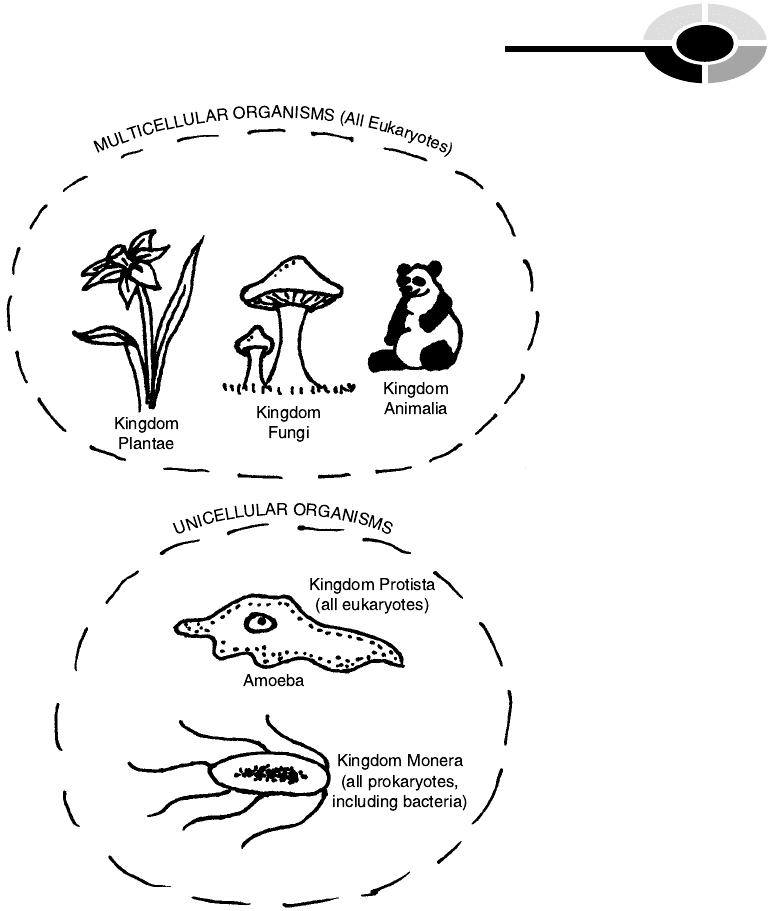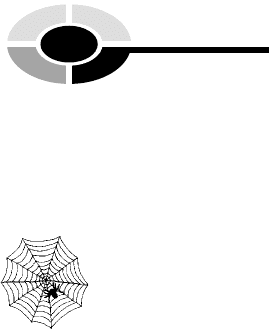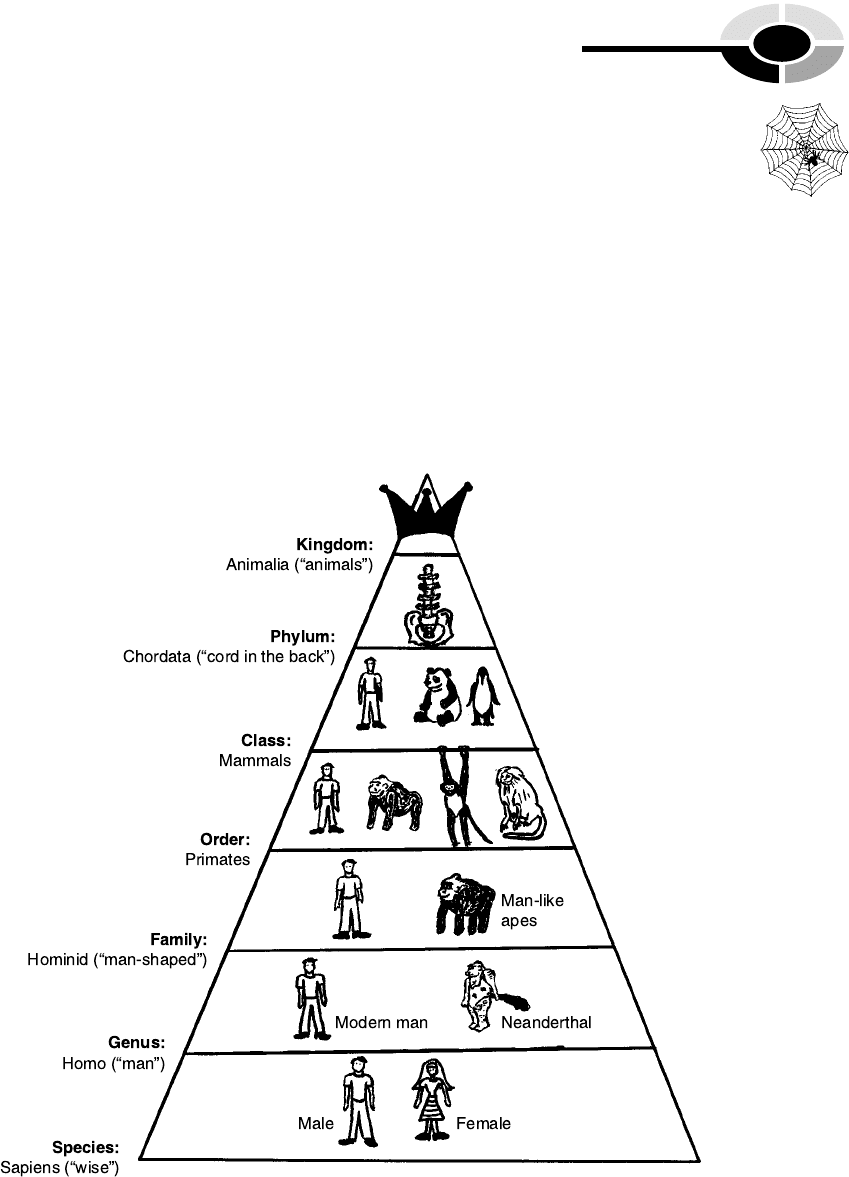Layman D. Biology Demystified: A Self-Teaching Guide
Подождите немного. Документ загружается.


[13:24 13/6/03 N:/4058 LAYMAN.751/4058-Alltext.3d] Ref: 4058 Layman: Biology Demystified All-text Page: 97 1-388
PART THREE
The Five Kingdoms
of Life, plus
Viruses
Copyright 2003 by The McGraw-Hill Companies, Inc. Click Here for Terms of Use.

This page intentionally left blank.

[13:24 13/6/03 N:/4058 LAYMAN.751/4058-Alltext.3d] Ref: 4058 Layman: Biology Demystified All-text Page: 99 1-388
99
CHAPTER
6
Bacteria and the
‘‘Homeless’’ Viruses
Bacteria as examples of prokaryotes (cells without nuclei) have already been
introduced. Chapter 3 identified bluish-green bacteria as being among the
first living things on Earth. And Chapter 4 further characterized the major
organelles found within bacteria. It explained how these differed from the
organelles found in the cells of most multicellular eukaryotes.
Chapter 6 now looks at the different types of bacteria in much more detail.
This chapter also provides an overview of the major bacteria-caused disor-
ders in infections of human, animal, and plant cells. Further, we will see how
viruses, in turn, can infect both the cells of bacteria, as well as those of other
living organisms.
Copyright 2003 by The McGraw-Hill Companies, Inc. Click Here for Terms of Use.

Classifying and Ordering: The Work of
Taxonomy
Chapter 3 traced the evolution and appearance of major types of organisms
in the Fossil Record. Besides ancient bacteria, there was discussion of plants,
fungi, and animals. Such defining and classifying of different groups of
organisms is the essential work of taxonomy (tacks-ON-oh-me). Taxonomy
looks for general rules or ‘‘laws’’ (nom) for the ‘‘arrangement’’ or ‘‘ordering’’
(tax) of organisms into groups of various sizes. As such, it is an essential
feature of Natural History (Chapter 1).
THE FIVE-KINGDOM SYSTEM OF CLASSIFICATION
Ever since Aristotle and other early naturalists began observing and collecting
observations about organisms, just how to classify them into particular
groups for convenient study has been a major issue. Taxonomy involves no
set laws or rules of Nature. Rather, it is a human-constructed way of assigning
organisms to particular groups, using highly orderly and systematic methods.
Because it is human-made, there is no single rock-solid way of classifying
organisms. Instead, there are a number of different ordering systems or king-
doms commonly used by taxonomists (tacks-ON-oh-mists). Perhaps the most
simple of these methods is the Five-Kingdom System. As Figure 6.1 clearly
illustrates, the Five-Kingdom System consists of three kingdoms of multi-
cellular (many-celled) organisms, plus two kingdoms of unicellular (single-
celled) creatures. According to this system, most multicellular creatures
belong to either the Kingdom Plantae (PLAN-tie), Kingdom Fungi,or
Kingdom Animalia (an-ih-MAIL-ee-uh). Obviously, these are the kingdoms
of plants, fungi, and animals. And all single-celled organisms belong to either
the Kingdom Protista (proh-TIS-tah) or Kingdom Monera (muh-NIR-uh).
Kingdom Protista consists of the protists (PROH-tists). Protists are often
considered the ‘‘very first’’ (protist), that is, the most ancient, of all types of
organisms. They are also among the simplest. The protists are eukaryotes,
having a nucleus, but they are generally simpler than most plants, fungi, and
animals. For example, the protist kingdom includes the amoebas (uh-ME-
buhs). An amoeba is a single-celled eukaryote (Figure 6.1) that frequently
‘‘changes’’ (amoeb) the shape of its body as it moves through its environment.
Kingdom Monera is the one that includes the bacteria and all other types
of prokaryotes. Since they lack a nucleus, all of the organisms within this
[13:24 13/6/03 N:/4058 LAYMAN.751/4058-Alltext.3d] Ref: 4058 Layman: Biology Demystified All-text Page: 100 1-388
PART 3 Five Kingdoms of Life, plus Viruses 100
1, Web
2, Web

kingdom have cells with cytoplasm that essentially stands ‘‘alone’’ (moner).
The bacteria and other monerans (muh-NIR-uns) also lack other membrane-
enclosed organelles, such as mitochondria and Golgi bodies. Monerans thus
have only the most basic facets of cell anatomy and physiology.
Despite small cell size and structural simplicity, however, the Kingdom
Monera and its vast populations of prokaryotes (such as bacteria) make up
the majority of the Earth’s biomass or ‘‘living weight.’’ All of the bacteria on
this planet, added together, weigh far more than all the elephants and whales
and human beings combined!
CHAPTER 6 Bacteria and Homeless Viruses 101
[13:24 13/6/03 N:/4058 LAYMAN.751/4058-Alltext.3d] Ref: 4058 Layman: Biology Demystified All-text Page: 101 1-388
Fig. 6.1 The Five-Kingdom System of classification.

FINER CLASSIFICATION BELOW THE KINGDOM LEVEL
Taxonomists also recognize a number of levels of classification of organisms
below the kingdom level. You may remember (from Chapter 2) that there is a
Pyramid of Life. In this pyramid, the horizontal layers are the various levels
of biological organization, starting with subatomic particles at the base, and
finishing with an ecosystem at the peak. Taking a similar approach, Figure
6.2 shows a Pyramid of Classification. At the broad base of this new pyramid
lies the species. A species consists of individual organisms of a certain ‘‘kind’’
(species). In a practical sense, two different organisms (male and female) are
considered to be members of the same species if they can successfully repro-
duce to create fertile offspring.
Above the species level lies the genus (JEE-nus). The word genus comes
from the Latin for ‘‘stock’’ or ‘‘kind.’’ A genus usually consists of two or
more species belonging to the same ‘‘stock.’’ This means that the related
species making up a particular genus or stock have certain structural and
functional characteristics in common. Further, these shared characteristics
make the members of a particular genus distinctly different from any other
group. In Kingdom Animalia, for example, we have the genus Homo (HOH-
moh) or ‘‘man.’’
Taxonomists give a two-part Latin name to each species of organism. The
first name (capitalized) is the genus, while the second is the species. We
modern humans, for example, are classified as Homo sapiens (SAY-pee-
enz) or ‘‘wise’’ (sapiens) ‘‘man.’’ The human race, for all its problems, may
not really be considered wise, but it is the only surviving species of the genus
Homo. The Fossil Record has provided abundant evidence of other (now
extinct) species within the Homo genus, such as Homo habilis (HA-bih-lis),
Homo erectus (e-REK-tus), and Homo australopithecus (aw-stray-loh-PITH-
eh-cuss).
Above the genus in the Pyramid of Classification lies the Family level. In
taxonomy, a family consists of a group of related genera (JEN-er-ah, the
plural of genus). Members of Homo sapiens, for instance, belong to the
hominid (HAHM-ih-nid) or ‘‘man-shaped’’ family. Modern human beings
and the man-like apes belong to the hominid family.
Next comes an Order of organisms. An order is a collection of related
families or organisms. Homo sapiens belongs to the Primate Order, as do
apes, monkeys, and lemurs.
Beyond the order is the Class. In taxonomy, a class is a particular group of
related orders. Human beings and other members of the Primate Order, for
instance, belong to the wider and more general Class Mammalia (mah-MAY-
lee-ah) or ‘‘mammals.’’
[13:24 13/6/03 N:/4058 LAYMAN.751/4058-Alltext.3d] Ref: 4058 Layman: Biology Demystified All-text Page: 102 1-388
PART 3 Five Kingdoms of Life, plus Viruses
102
3, Web

[13:24 13/6/03 N:/4058 LAYMAN.751/4058-Alltext.3d] Ref: 4058 Layman: Biology Demystified All-text Page: 103 1-388
Similar classes are grouped into a certain phylum (FIGH-lum). All Class
Mammalia creatures are found within the still-larger category of the Phylum
chordata (kor-DAY-tuh). The chordates (KOR-dates) are organisms with a
slender ‘‘cord’’ in their backs, sometime during their development. All mem-
bers of the Class Mammalia have such a slender cord, which eventually
develops into a mature vertebral (ver-TEE-bral) column, or ‘‘jointed back-
bone,’’ in the adult.
Finally, the highest taxonomic category of them all is the Kingdom. A
kingdom consists of a group of related phyla (FIGH-lah, plural of phylum).
All backboned organisms in the Phylum Chordata (including humans, of
course), belong to the Kingdom Animalia.
CHAPTER 6 Bacteria and Homeless Viruses 103
4, Web
Fig. 6.2 The Pyramid of Classification for all types of organisms.

Classifying and Ordering Bacteria: The ‘‘Kings’’
of Monera
The Pyramid of Classification will be mentioned again and again, as we
encounter various organisms in later chapters. In this chapter, however,
the main emphasis will be on the characteristics of bacteria.
Most of the prokaryotes (monerans or members of the Kingdom Monera)
known about, today, are bacteria. Hence, we can nickname the bacteria as
the ‘‘kings’’ of Monera! One relatively simple way of classifying bacteria is
the way they react to particular biological dyes or stains, such as the iodine-
rich Gram stain. Bacteria are classified as being gram-positive if they stain
violet with the Gram stain. They are called gram-negative if they lose the
violet and take the color of the red opposite stain.
Another way of classifying bacteria and other monerans is by the general
way in which they get their energy supplies. Recall from Chapter 4 that
autotrophs are self-nourishing organisms, often relying upon photosynthesis
for their ATP. And, likewise, remember that heterotrophs are nourished
from some other source beyond themselves, usually by eating organic food-
stuffs. Bacteria, too, can be classified as either autotrophs or as heterotrophs.
Among the autotrophs, there are two additional classifications, according
to the specific way in which the bacteria are self-nourishing. Photoautotrophs
(FOH-to-aw-tuh-trohfs) contain chlorophyll and use light and photosynthesis
for their energy. Chemoautotrophs (KEM-oh-aw-tuh-trohfs) use chemical
reactions, such as nitrogen-fixation, to produce their food. Nitrogen-fixing
bacteria take nitrogen gas (N
2
) out of the atmosphere and get energy by
converting it into ammonia (NH
3
) or ammonium (NH
þ
4
). Nitrogen-contain-
ing organic compounds like these, once produced by chemoautotrophs, are
then used by green plants for their own metabolism.
THE MAJOR TYPES OF BACTERIAL SHAPES
In addition to classifying bacteria by the way in which they obtain their
energy, they can also be slotted according to their shape (see Figure 6.3).
A coccus (COCK-us), or in plural form cocci (COCK-see), is rounded and
sphere-shaped, like a ‘‘berry.’’ A single berry-shaped bacterium is technically
called a micrococcus (MY-kroh-cock-us). Diplococci (DIP-low-cock-see), in
contrast, are ‘‘double berries.’’ The diplococci are a group of spherical bac-
teria that occur in pairs (hence, doubles). Strept (STREPT) means ‘‘twisted.’’
[13:24 13/6/03 N:/4058 LAYMAN.751/4058-Alltext.3d] Ref: 4058 Layman: Biology Demystified All-text Page: 104 1-388
PART 3 Five Kingdoms of Life, plus Viruses
104

Hence, the streptococci (STREP-toe-cock-see) are a genus of berry-shaped
bacteria found as long twisted chains. Finally, consider the staphylococci
(STAF-ill-oh-cock-see). These rounded, berry-like bacteria assume the
shape of a ‘‘bunch of grapes’’ (staphyl).
In contrast to the rounded coccus form are the bacillus (bah-SIL-us) or
‘‘rod’’ shape and the spirillum (spy-RIL-um) or ‘‘coil’’ shape. Similar to the
coil shape taken by the spirilla (spy-RIL-uh) is the ‘‘coiled hair’’ arrangement
assumed by the spirochetes (SPY-row-keets).
Bacterial Order versus Disorder
Many types of bacterial species live in the soil, water, on the skin, and even
within the intestines of human beings. Most bacteria participate in orderly
relationships with their hosts (the creatures they live upon). There is often a
condition of symbiosis (sim-be-OH-sis) – a successful ‘‘living together.’’ For
CHAPTER 6 Bacteria and Homeless Viruses 105
[13:24 13/6/03 N:/4058 LAYMAN.751/4058-Alltext.3d] Ref: 4058 Layman: Biology Demystified All-text Page: 105 1-388
Fig. 6.3 Some major types of bacteria.
5, Web

example, Escherichia (esh-er-IKE-ee-ah) coli (KOH-lie), often abbreviated as
E. coli, is a type of bacillus commonly found in the colon (large intestine) of
humans and other animals. Normally, E. coli lives in symbiosis with its
human body host. These bacteria, along with many others, help produce
certain B vitamins as well as sulfur-containing amino acids, which are then
absorbed into the human bloodstream. In return, the E. coli benefit by con-
suming glucose and other organic molecules found within the large intestine.
Hence, the individual human being successfully lives together with the mil-
lions of E. coli and other bacteria in the colon.
BACTERIAL FOOD POISONING AND BLOOD INFECTION
Many bacteria produce exotoxins (EKS-oh-tahk-sins) or ‘‘outside poisons,’’
and then release these poisons into the surrounding environment. Even some
types of E. coli bacteria, for example, when they are consumed in fecal-
contaminated food or water, result in bacterial food poisoning. The acciden-
tally consumed E. coli can release exotoxins, severely irritating the walls of
the stomach and intestines, and giving the affected person a really bad case of
traveler’s diarrhea.
The other major problem associated with numerous bacteria are endotox-
ins (EN-doh-tahk-sins). These ‘‘inner poisons’’ are contained within the cell
walls of certain gram-negative bacteria. Salmonella (SAL-moh-nel-AH) bac-
teria, for instance, are a genus of rod-shaped bacilli consisting of more than
1,400 separate species, most of which contain endotoxins in their cell walls.
When such Salmonella are consumed in contaminated food (like raw chicken
or hamburger), they may cause severe bacterial food poisoning.
E. coli or other bacteria sometimes enter the bloodstream, perhaps
through a dirty open wound in the surface of the skin. The result is bacter-
emia (bak-ter-EE-me-ah), alternately called septicemia (sep-tih-SEE-me-ah) –
‘‘a condition of bacteria or rotting’’ (sept) within the ‘‘blood’’ (-emia).
Bacteremia (septicemia) in our normally sterile human bloodstream can cre-
ate severe fever and widespread scarring and infections.
Finally, various health problems may result when the normal delicate
balance among different types of bacteria within the human body is suddenly
disrupted. Consider the excessive and prolonged use of general antibiotics,
such as penicillin. Too much penicillin, taken for too long, can destroy
beneficial bacteria and allow antibiotic-resistant strains of bacteria to
develop. As these resistant bacteria multiply, they can create infections that
are very difficult to treat.
[13:24 13/6/03 N:/4058 LAYMAN.751/4058-Alltext.3d] Ref: 4058 Layman: Biology Demystified All-text Page: 106 1-388
PART 3 Five Kingdoms of Life, plus Viruses
106
1, B-Web
2, B-Web
3, B-Web
